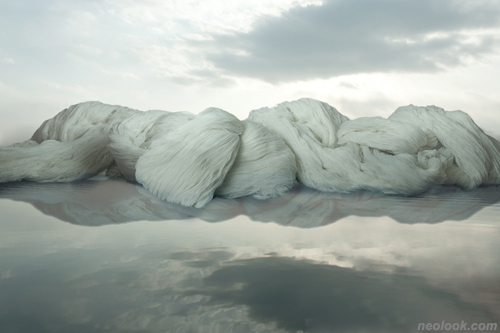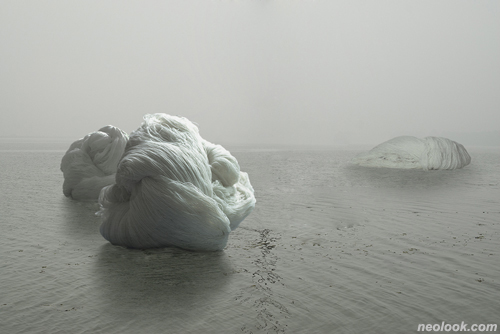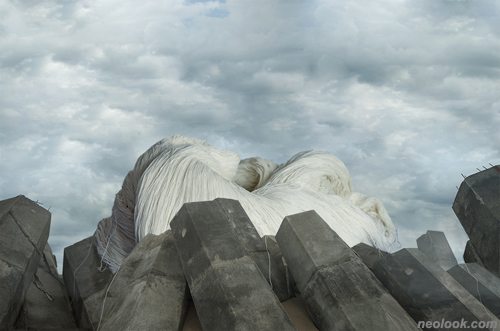- ● homepage
- ● archives
- ● restoration
- ● books
- ● big banners
- ● post board
- ■ neo's search
- ■ about us
- ■ 게재방법 안내
- 개인정보처리방침

- [email protected]
- Tel. 02_335_7922
- Fax. 02_335_7929
- 10:00am~04:30pm
- 월요일~금요일
- 3/3(월) 대체공휴일

기억은 자신으로부터 오지 않는다: Oblivion
이민호展 / LEEMINHO / 李玟鎬 / photography 2016_0302 ▶ 2016_0405 / 일요일 휴관
● 위 이미지를 클릭하면 네오룩 아카이브 Vol.20150224c | 이민호展으로 갑니다.
작가와의 대화 / 2016_0318_금요일_07:00pm
관람시간 / 10:00am~06:00pm / 수요일_02:00pm~06:00pm / 일요일 휴관
비컷 갤러리 B.CUT CASUAL GALLERY&HAIRDRESSER'S 서울 서대문구 연희로11라길 37-7 Tel. +82.2.6431.9334 blog.naver.com/bcutgallery
기억은 자신으로부터 오지 않는다 ● "저는 제 자신을 기억하고 있지 않았어요. 기억은 저로부터 오지 않았습니다." (모리스 블랑쇼, 『기다림, 망각』, 그린비, 2009, 91쪽) / "나는 나를 이해하고 싶고, 나를 이해시키고 싶고, 알리고 싶고, 포옹 받게 하고 싶고, 누군가가 와서 나를 데려가기를 바란다." (롤랑 바르트, 『사랑의 단상』, 동문선, 2004(1977), 95쪽)

- 이민호_Fil blanc n. 6_Ed.1/5_잉크젯 프린트_67×86.4cm_2016
우리는 창작이 삶에서 길어온다는 것을 잘 알고 있다. 삶은 계획대로 만들어지지 않는 불가항력의 장이다. 예술적 창작이란 단순히 이미지를 생산하는 행위가 아니라 이미지를 통해 어떤 성찰을 감행하려는 의지의 순간이자 본질적인 고민의 시간이니 말이다. 롤랑 바르트는 사랑이란 감정을 이미지를 들춰낼 뿐 반사작용(reflectivity)에 다다르기는 어렵다고 설명한다. 사랑에 빠진 사람은 사랑을 통해 성찰하고 싶지만 늘 실패하는 사람이란 의미처럼 들린다. 사랑에 빠진 사람은 기억을 표상하는 이미지를 모아놓은 사람이다. 바르트가 사진을 관찰하는 방식도 사랑의 방식과 유사하다. 작가가 주목하는 주제가 화면의 중앙에 위치하고 있으나, 결국 우리가 관심을 보이는 대상은 중심 주변에 우연히 포착된 무엇이다. 이처럼 중심 주변을 배회하다가 전혀 상관없는 대상을 주목하게 되는 것이 삶이 아닐까? 이처럼 이민호의 사진은 그녀가 배회하는 주변에서 생성된다. 그녀에게 사진은 자신의 삶의 배경이자 모든 창작을 위한 요소이자 그것은 작가가 있던 그곳, 그녀가 본 풍경의 기록이자 '기억의 표상'이 된다. 이렇게 차곡차곡 쌓인 기억의 원소들은 다시 사진 화면 위에 재배치되어 또 다른 새로운 세계로 펼쳐진다. 그녀의 예술세계를 관통하는 개념인 "휴대풍경(portable landscape)"은 일화적인 기억의 단편들을 모은 이미지가 아니라 작가가 사는 일상의 장면부터 여행 중 우연히 발견한 장소들의 이미지를 뒤섞어 일상과 일탈이 교차하도록 재배치한 가상적 풍경이다.

- 이민호_Fil blanc n. 18_Ed.1/5_잉크젯 프린트_70×70cm_2016
사진으로의 탈영토화 ● 사실 이민호는 한국에서는 사진작가로 알려졌지만 파리 유학 시절에는 화가로서의 활동이 더 두드러졌다. 그녀의 회화는 지금의 사진과 달리 무채색 계열의 어둡고 다소 무거운 분위기의 작업이었다. 1990년대 말 회화에서 사진으로 매체를 바꾸고 작업의 분위기도 상당한 변화를 보이기 시작한다. 회화 작업에는 다소 직설적으로 보일 정도로 관념적인 존재에 관한 물음을 부여잡고 있었다. 그러나 자연스레 사진으로 이동하면서 화면의 구성이 다층적으로 바뀌고 팔레트가 다양해지기 시작했다. 전형적인 사진 교육을 받지 않았기에 앵글의 각이나 위치도 자유로울 수밖에 없었다. 작가는 회화에 대한 관념적 고민에서 벗어나 자신의 주변을 사진으로 담으면서 자연스레 인물과 풍경을 주목한다. 흥미로운 점은 회화와 사진에서 얼굴의 상부를 의도적으로 잘라내는 점이다. 시선이 사라진 인물은 개인성을 지우고 익명성을 강조하기 위한 선택이지만 사진의 경우 이러한 구도는 시선의 상실에 의해 오히려 몸과 옷차림에 의해 대상을 파악하도록 유도하게 만들었다. 이민호의 풍경 사진은 피토레스크(pittoresque, 전경 또는 경치)의 개념보다 풍경의 파편들의 콜라주라 부를 수 있다. 전체가 아닌 부분, 거대서사가 아닌 풍경 또는 장소의 일부 단서들을 재구성하는 방식은 가장 작은 풍경이라 할 수 있는 텃밭의 일부와 자신의 작업실, 여행 중 묵은 호텔방, 우연히 발견한 버려진 건물의 실내외의 일부를 자르고 붙이는 과정으로 만들어진다. 사진 속 풍경의 콜라주는 장소의 정체성을 탈영토화한다. 조각난 풍경들은 다양한 장소를 지시하는 단서들이자 풍경 개념의 질료로 볼 수 있다. 이 질료들은 원래의 문맥에서 벗어나 또 다른 장소로부터 탈주한 풍경들과 접속한다. 이전의 시간이 이후의 시간과 만나고 과거의 기억이 현재의 기억과 얽히면서 이민호의 사진은 불가능한 현실, 시간과 기억의 지층을 변위(displaced)한 리토르넬로를 생성한다.

- 이민호_Fil blanc n. 18_Ed.1/5_잉크젯 프린트_70×70cm_2016
이번 전시 『그렇게 끝없이, 미로-아리아드네의 실』은 그녀가 그 동안 찍었던 사진의 주변에 자주 배경처럼 등장하던 공장, 공장굴뚝, 굴뚝의 연기를 대지와 공기, 땅과 하늘을 이어주는 매개체로 제시한다. 이전의 시간에서 찾은 공통의 단서 속에 실타래라는 새로운 기호가 삽입된다. 끊임없는 운동을 통해 에너지와 산물을 생산하는 공장의 굴뚝에서 나오는 연기는 사회학자나 환경주의자에게는 비판의 대상이겠지만 시인의 눈으로는 매일매일 똑 같은 일상을 반복해야만 하는 생존의 동력이자 삶의 조건으로 비추어질 것이다. 생명과 인연을 상징하는 실타래는 마치 운명의 신비라도 풀려는 듯 청회색 공기와 꿈틀대는 잿빛 연기 사이에서 길을 인도하는 듯하다. 그러나 중요한 것은 기표들에 대한 확장된 해석이나 신비주의적 의미론이라기보다 작가가 펼친 시간과 기억으로 배치된 패치워크를 어떻게 구성했는지를 살펴보는 것이다.

- 이민호_Fil blanc n. 40_Ed.2/5_잉크젯 프린트_100×150cm_2015
사진 콜라주라는 리토르넬로 ● 탈영토화된 여러 시간과 기억은 사진 콜라주 화면 안에서 재영토화된다. 그것이 특별한 새로운 기억을 만드는 것도 아니고 특정 주제를 시사하지도 않는다. 오히려 우리가 주목해야 할 것은 어떻게 실재로부터 추출한 시각적 단서들이 화면 안에 재영토화하고 있는지에 관한 것이다. 이민호의 사진 속 이미지들-기억들-시간들은 저마다 다른 문맥에서 발췌된 것들로 구성된 세계이다. 사실 포토샵으로 원 이미지를 자르고 재접합해 의외의 대상이나 장소를 만드는 건 동시대 '조형적' 사진의 특성이다. 이러한 조형적 사진은 일반적으로 실재보다도 더 실제적인 가상세계를 재현하고자 한다. 실재와 가상의 모호한 경계로 만들어진 세계의 시각적 스펙터클은 회화에 대한 동시대 사진의 가능성을 주장하는 것처럼 보이기도 한다. 실제로 사진은 오랫동안 그리고 여전히 회화와의 대결을 요구하고 있다. 반면 회화에서 사진으로 탈주한 이민호의 경우는 이러한 주체적 예술 매체라는 쟁점으로부터 비교적 자유로운 듯하다. 작가는 완벽한 가상세계를 만들기 위해 노력하지는 않는다. 오히려 사진이란 기술을 이용해 회화적 태도를 연장하는 데 집중한다고 덧붙인다. 이는 회화와 사진 간의 오랜 경쟁과는 사뭇 다른 접근이다. 그렇다고 그녀가 사진으로 회화를 한다는 의미로 해석할 수는 없다.

- 이민호_Fil blanc n. 41_Ed.1/5_잉크젯 프린트_100×150cm_2016
오히려 다음의 질문을 던져보자. 회화란 캔버스와 물감을 사용해 창작하는 것을 의미하는가? 구상과 추상의 차이를 거론하지 않고 회화의 조건이란 단순히 질료적인 것만으로 충족될 수 있는가? 사진의 경우도 마찬가지이다. 사진기로 촬영을 하고 인쇄를 한다고 해서 사진의 개념을 충족하는가? 일련의 질문은 철학적 사유를 요구한다. 그림을 그리고 사진을 찍는 행위는 창작의 형태를 분류하는 기본이지만, 사실 회화적 사유, 사진적 사유라는 차원으로 바꾸어 생각해보면 단순히 매체만의 속성으로 구분할 수만은 없는 게 아닐까? 베허 부부의 사진이 베니스비엔날레에서 조각상을 받고 로버트 롱고의 몸부림치는 인물사진이 조각의 차원을 사진적으로 해석하고자 했던 예를 생각해보자. 볼프강 틸만이 사진을 찍지 않고 인화지와 빛의 관계만으로 미니멀 회화와 유사한 결과를 유도한 실험도 떠올려보자. 매체는 하나의 도구일 뿐 더 이상 결정적인 분류법으로 수렴될 수 없다. 그렇다면 이민호의 사진 역시 회화적 사유를 사진 매체로 탈영토화한 것으로 해석할 수 있는 여지가 있다. 그림을 그리는 행위가 아니라 사진의 파편들을 모아 화면 안에 재구성하여 완벽한 가상세계를 만드는 게 아니라 오히려 사진의 세계가 익명적인 장소들과 개인적인 삶의 편린으로 배치된 이질적 시공간과 기억으로 채워 새롭게 만들어낸 리토르넬로(반복구)가 아닌가. 그것은 초현실주의 회화가 이질적인 요소들로 하나의 세계를 구성한 것과 달리 이질적인 요소들이 저마다의 존재를 드러내기 위한 수단으로도 해석 가능하다. 즉 회화에서 사진으로 탈영화를 감행한 이유가 단순히 매체를 바꾸었다는 사실이 아니라 작가 자신에게 더 가깝게 다가가기 위해 리듬, 강도에 맞는 질료를 선택했다는 표현이 보다 적절할 것이다. ● 기억이 자신으로부터 오지 않는다는 모리스 블랑쇼의 문장은 기억이 절대로 스스로 내게 말을 걸지 않는다는 것으로 이해된다. 기억의 리토르넬로가 노래로 들리는 경우는 아마도 의도치 않은 사건의 등장으로 촉발되는 것일 테니 말이다. 이민호는 자신의 앨범을 뒤적거리면서 우연히 기억을 끄집어 낼 것이다. 일상의 무료함과 고독을 이겨내기 위해 텃밭의 식물에 시선과 여행 중에 찾아간 빈 집이 주는 의아함 그리고 의도와 상관없이 찍힌 주변의 배경들을. 반복적으로 재배치되어 화면 안에 자리잡고 있는 이러한 요소들(창작의 원소들)은 되돌아오는 후렴구처럼 작업 전반에 나타난다. "리토르넬로라는 개념을 통해서 삶을 살아가는 시간이 선형적이고 무료한 반복이 아니라, 각각 서로 다른 존재의 다채로운 화음이 서로 어우러지는 것"을 알 수 있다고 철학자 신승철은 말한다(식탁 위의 철학, 동녘, 2012, 16쪽). 그것은 익히 알고 있지만 낯설게 다가오는 언캐니 한 세계 속에 자신의 영토를 만드는 행위이다. 마치 어린아이가 익숙한 일상의 재료들로 새로운 영토를 되풀이해서 만드는 것처럼 말이다. ■ 정현

- 이민호_Fil blanc n. 43_Ed.1/5_잉크젯 프린트_47×73cm_2016
What I Remember Does not Come from Me ● "I did not remember myself, that which did remember did not come from me." (Awaiting, Oblivion (L'Attentel'oubli) by Maurice Blanchot) / "I want to understand me, enlighten me, make known me, get me hugged, and someone to take me." (A Lover's Discourse: Fragments by Roland Barthes) ● We are well aware that creation is derived from life. Life is the forum of force majeure where all is not done as we have planned. Artistic creation is not a mere action of producing images but the moment of one's will to endeavor some introspection or a time of elemental agony. Roland Barthes explains that we just unveil images and cannot reach a true work of reflectivity through a feeling of love. One who falls in love wants to introspect something through love but he or she seems to always fail. One who falls in love is one who gleans images representing memories. A way Barthes observes love is similar to that of love. The theme to which an artist pays attention is found at the center of the scene but we display our concern to something captured in its periphery. Is life that we take note of objects that have nothing to do with us while wandering the periphery? As such, Lee Minho's photographs derive from the surroundings she wanders. To the artist, a photograph is the background of her life, an element of all creation, a record of the place where she stays and the landscape she sees: "a symbol of her memory." The elements of memories accumulated are rearranged in her photographic scenes, unfurling another world. "Portable landscape," a principal concept of her art is not an image stemming from one-off fragments of memories but an imaginary scene created through an interweave of her everyday scenes and the images of places she discovered by chance on her journey. Photographic deterritorialization ● Lee Minho is known as a photographer in Korea but she worked as a painter when studying in Paris. Unlike her photographs, Lee's paintings aroused a rather gloomy, heavy atmosphere, applied with achromatic colors. Lee made a turnaround from painting to photography in the late 1990s, while changing her work's atmosphere considerably. In her painting work she was consistently absorbed in rather blunt questions concerning ideal existence. After naturally changing her primary medium to photography however, her work's composition appears multilayered and her palette becomes diversified. As she did not take any formal photography education, her option of angles and locations is not confined by any regulation. While capturing her surroundings, escaping from any ideal consideration of painting, Lee has naturally put focus on figures and landscapes. Interesting is her intentional cutting of the upper parts of faces in her paintings and photographs. This is to get rid of a figure's individuality and instead emphasize anonymity, but in her photography this composition allows viewers to grasp photographic subjects by their bodies or clothing. Lee's landscape photographs are not defined by the concept of "pittoresque" but can be referred to as collages of the fragments of landscapes. Her way of recomposing part not whole or some parts of an entire scene is like a process of cutting and putting together parts of the scenes of her studio, a hotel room where she stayed, and the indoor of an abandoned building. Her collages of landscapes in her photographs deterritorialize a place's identity. The landscapes broken into pieces can be seen as clues to diverse places or materials for the concept of landscapes. These materials are connected to other landscapes running away to other places, escaping from their original context. As previous time meets posterior time, and past memories are interwoven with present memories, Lee's photographs form ritornelli by displacing impossible realities and layering time and memory. In this exhibition So Endlessly, the Labyrinth-Ariadne's Thread, Lee presents factories, factory chimneys and the emitted smoke she has often featured as the backgrounds of her photos as the mediums of the earth, air, and the sky. A skein of thread is inserted into the common clue she discovered in previous time. The smoke puffed out from the chimney of a factory that turns out energy and products through its incessant movements is an object of criticism by sociologists or environmentalists but may be seen as the motive power for survival or the condition of life by poets. The skein of thread standing for life and connection seems to guide us somewhere between bluish gray air and wriggling ash-colored smoke. What's significant is not any expanded interpretation of the signifiers or any mystical semantics, but to examine how the artist has constructed a patchwork of unfolded time and memory. Ritornelli of photo collage ● Deterritorialized time and memory are reterritorialized within a photo collage scene. This does not generate any new memory or intimate any specific theme. Rather noteworthy is how visual clues elicited from reality are reterritorialized in the scene. Lee's images, memories, and times in her photographs are of a world composed of things taken out from different contexts. One of the hallmarks of "formative" photographs of our time is to create unexpected objects or places by digitally processing original images such as cutting and recombining them with Photoshop. Photographs today intend to represent an imaginary world that is more realistic than the real in such "formative" photographs. Visual spectacles in the world where the vague boundaries between reality and imagination become blurred seem to claim the possibilities of photography over painting. In fact, photography has long vied with painting. In contrast, Lee Minho seems comparatively free from the debate on such subjective medium of art as a painter-turn-photographer. She does not make any effort to create a complete imaginary world. Rather, she seems to expand her pictorial attitude by using photographic technique. This is an approach indifferent to a long-standing competition between painting and photography. And yet, it cannot be interpreted that she does painting with photography. We can pose questions such as "Does painting mean to create something with canvas and paint?" and "Can we meet the requirements of painting simply with something material without mentioning any different between figuration and abstraction?" So does time. Is taking photos with a camera and printing them to meet the requirements of photography? These questions demand our philosophical thought. An act of painting and photographing are the fundamentals of creation. If considering them in the dimensions of pictorial or photographic thoughts, such acts cannot be distinguished only with the attributes of mediums. Examples are Bernd and Hilla Becher who won a sculpture prize at the Venice Biennale, Robert Longo who tried to interpret the dimension of sculpture photographically with his figure photographs featuring writhing persons, and Wolfgang Tillmans who attained the results of his experiments similar to minimalist painting only with the relation between printing paper and light. A medium is nothing but a device, not depending on any classification system. If so, Lee's photographs can be interpreted as a deterritorialization of the medium of photography anchored in pictorial thought. Her works are not a perfect imaginary world created through the gleaning and reconstruction of photographic fragments but the ritornelli filled with her memories in the heterogeneous space-time arranged with fragments of anonymous places and individual life. Unlike Surrealist paintings in which heterogeneous elements form the world, such factors can be interpreted as the means to reveal each existence in her work. That is, we can more properly explain that she has endeavored to deterritorialize her art from painting to photography to approach closer to herself with the materials such as rhythm and intensity. ● We understand what Blanchot said, "I did not remember myself, that which did remember did not come from me." as that memories in no way speak to us. The ritornelli of memories that sound like a song are perhaps stimulated by the emergence of unintended events. Lee may draw out her chance memories from her photo albums. The elements (elements of creation) that are rearranged repetitively, such as plants that help her overcome the boredom and solitude in life, curiosity about an empty house she met on her journey, and backgrounds captured by chance appear in her oeuvre like a recurring song. Philosopher Shin Seung-cheol alludes that "We can realize that the time of our lives is not linear, tedious, and repetitive but a good mix of diverse harmonies from different beings through the concept of ritornelli." This is an act of occupying her own territory in an uncanny world we are familiar yet appear unfamiliar as if a child acquires a territory repetitively with familiar everyday materials. ■ Jung Hyun
Vol.20160302b | 이민호展 / LEEMINHO / 李玟鎬 / photography

